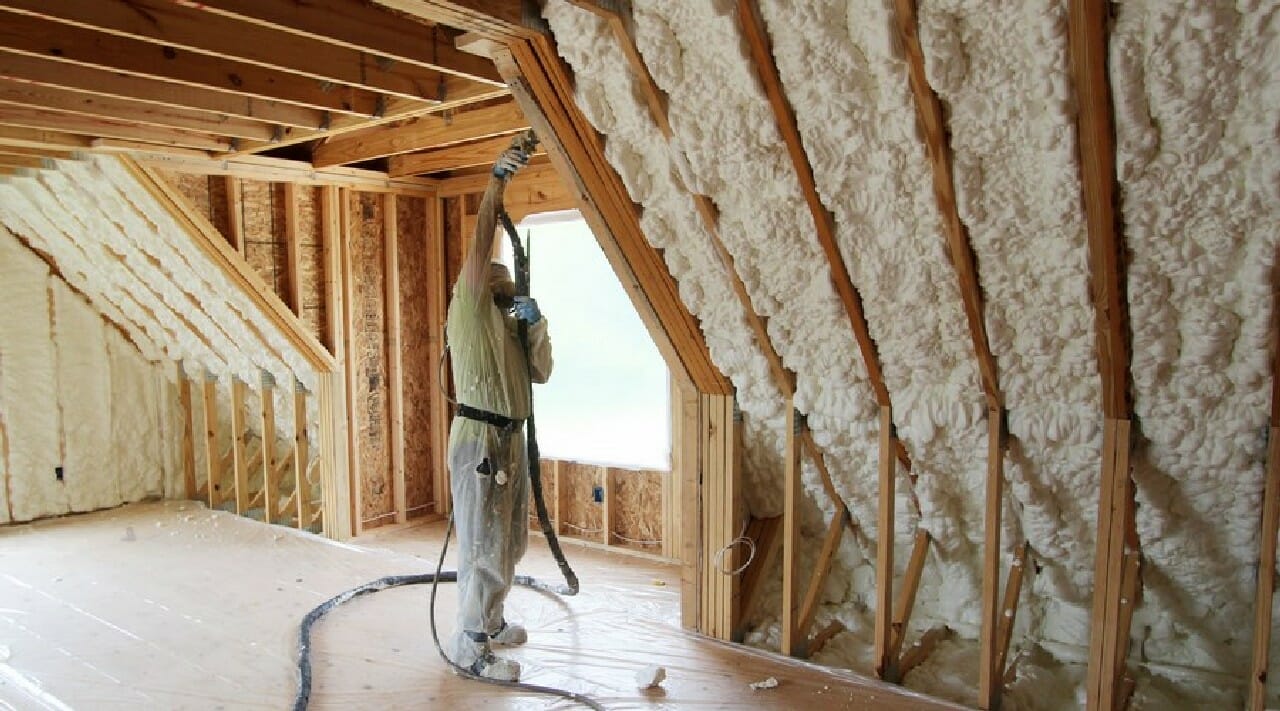
Spray foam insulation is often chosen for its thermal performance, but not all building owners realize it can help with sound control as well. In particular, open-cell spray foam offers notable acoustic benefits alongside its energy efficiency properties. Whether the concern is reducing indoor echo in a commercial space or limiting outdoor noise in a residential area, open-cell foam can be a useful option.
This article explains how open-cell spray foam contributes to soundproofing, compares its performance to other insulation types, and answers common questions for those evaluating whether it’s the right fit.
How Open-Cell Spray Foam Reduces Sound Transmission
Open-cell spray foam contains millions of air-filled pockets that trap sound waves and reduce their ability to travel through walls or ceilings. It does not block sound completely but limits the echo and vibration that contribute to overall noise.
How It Works
The foam expands into framing cavities and fills gaps that would otherwise allow sound to pass through. The open-cell structure softens airborne noise and reduces reverberation.
- Absorbs mid- and high-frequency sounds
- Limits structural vibration through wall assemblies
- Diminishes hollow sound effects common in large rooms
Suitable Sound Types
Open-cell foam is more effective against airborne sounds than impact or structural noise. It performs well in applications where sound is transmitted through the air, including:
- Human speech
- Street noise
- HVAC or appliance hum
- Music or media systems
Coverage Areas That Benefit Most
Rooms with shared walls or large surface areas experience the most noticeable difference. Common installation points include:
- Interior walls between rooms
- Home offices or media rooms
- Ceilings below high-traffic floors
- Exterior-facing bedroom walls
Open-Cell vs Closed-Cell Foam for Sound Dampening
Both types of spray foam offer insulation benefits, but only one excels in reducing airborne noise transmission.
Core Differences in Structure
| Feature | Open-Cell Foam | Closed-Cell Foam |
|---|---|---|
| Cell Composition | Soft, flexible, air-filled | Rigid, dense, moisture-resistant |
| Noise Absorption | High (airborne noise) | Low (reflects sound) |
| R-Value | R-3.5 to R-4 per inch | R-6 to R-7 per inch |
| Weight | Lightweight | Heavy and dense |
| Water Resistance | Low | High |
Open-cell foam’s spongy texture and lower density allow it to absorb sound vibrations rather than reflect them back.
Application Scenarios
- Open-cell foam is better for interior sound control needs where humidity is not a concern.
- Closed-cell foam is more appropriate for exterior insulation, flood-prone areas, or where vapor barriers are necessary.
Residential Uses: Improving Everyday Comfort
Sound can travel easily in modern homes with open floor plans and shared living spaces. Open-cell spray foam adds value by creating quieter, more private environments.
Bedrooms and Shared Walls
Using spray foam in interior bedroom walls limits sound transfer between rooms. This is especially helpful in homes with children, roommates, or shift workers.
Media Rooms and Home Offices
Foam insulation in walls and ceilings helps contain noise from speakers or equipment, making it easier to focus or enjoy entertainment without disturbing others.
HVAC and Plumbing Noise
In homes with noisy ducts or pipes, open-cell foam dampens the mechanical sounds that travel through wall cavities.
Commercial Applications: Productivity and Noise Control
Soundproofing matters in offices, medical centers, retail stores, and other commercial spaces where acoustic comfort supports professional performance and customer satisfaction.
Offices and Conference Rooms
Noise reduction improves concentration and reduces distraction in open-concept workspaces. Spray foam also supports sound privacy during phone calls or meetings.
Retail and Hospitality
In restaurants or retail areas, lowering background noise contributes to a more pleasant customer experience. Foam-insulated walls and ceilings can limit ambient sound transmission between zones.
Multi-Use or Mixed-Occupancy Spaces
In buildings that combine residential and commercial tenants, open-cell foam can reduce sound transmission across uses—such as between a shop on the ground floor and apartments above.
What Open-Cell Foam Doesn’t Do
It’s important to understand the limits of open-cell foam’s acoustic abilities. It doesn’t eliminate all sound or substitute for specialized soundproofing materials in high-demand environments.
Not Ideal for Impact Noise
Footsteps on upper floors, dropped items, or vibrations from machinery are not fully addressed by open-cell foam. These noises often require:
- Resilient underlayments
- Sound clips and channeling systems
- Mass-loaded vinyl or acoustic panels
Not a Standalone Solution in High-Noise Zones
Areas exposed to loud exterior sources (airports, highways) may need layered acoustic strategies beyond foam alone.
Conclusion
Open-cell spray foam insulation services do more than just provide thermal protection—they enhance acoustic comfort by absorbing airborne noise and reducing sound transfer between rooms. With its flexible structure, lightweight design, and ability to fully fill cavities, open-cell spray foam is an excellent choice for residential and commercial spaces where noise control and energy efficiency are priorities.
Homeowners use it to make bedrooms quieter, manage noise in home offices, or reduce unwanted sound from HVAC systems. Commercial property owners apply it to support employee focus and improve the acoustic experience of their spaces.
While it’s not a complete soundproofing system, it’s a valuable tool when used strategically. Its dual purpose—thermal insulation and sound dampening—makes it a smart investment in both comfort and performance.
FAQs
How does open-cell spray foam compare to fiberglass for sound control?
Open-cell spray foam generally outperforms fiberglass in sound absorption. It fills cavities more completely, reducing gaps where sound can travel. Fiberglass slows sound but doesn’t block or absorb it as effectively.
Can open-cell foam reduce sound from neighbors or street noise?
Yes, open-cell foam can help reduce airborne sound from neighbors, traffic, or outdoor activity. It absorbs mid-range frequencies like speech and passing cars. For heavy or low-frequency sounds, it may need to be combined with other materials.
Is open-cell spray foam suitable for exterior walls in humid climates?
No, it’s not moisture-resistant and should not be used in areas where water vapor can enter. Closed-cell foam is better for exterior walls in humid or flood-prone locations.
Does open-cell spray foam add to fire resistance or safety?
It must be paired with an approved thermal barrier to meet fire safety codes. While it won’t prevent a fire, it can delay ignition depending on its formulation and installation context.
Can open-cell foam help with noise between floors?
To some extent. It helps reduce airborne sound like voices or music, but it’s less effective against impact noise from footsteps or dropped items. For floor-to-ceiling soundproofing, additional techniques are usually needed.
Author: With 15 years of banking experience and five years managing H&R Foam Insulation, Edith is passionate about building strong relationships with customers. Her favorite part of the role is connecting with clients and ensuring their needs are met as she works alongside them to improve the health, comfort, and energy efficiency of their homes.
Reviewer: With 7 years in the spray foam insulation business, Ella Adams offered useful feedback on this post, helping make sure the tips were both realistic and easy to apply.



